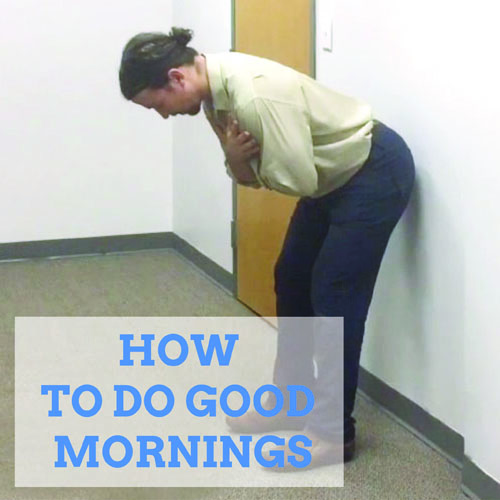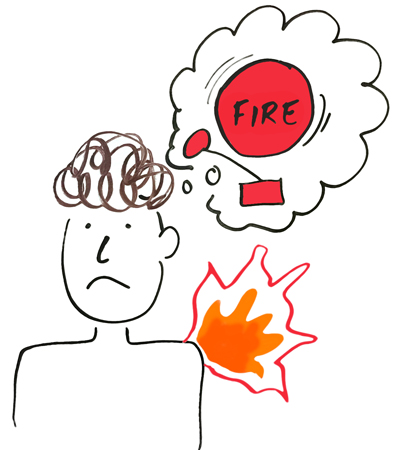
19 Dec One of the Best Exercises for Lower Back – The Good Morning
One of the best exercises for lower back pain, or preventing injury, is the good morning.
Why?
- It’s functional – it’s very similar to how you pick up things off the ground on a daily basis. Rarely, are you on all fours like you are when you perform a plank, the standard go-to for low back strengthening.
- It’s scaleable – you can do it bodyweight or with weight to your chest or on your back.
- It’s unforgiving – do it with bad form, too quickly, or increasing weights too fast and, well, you won’t be doing them for long!
Here’s how to do a good morning.
How to Do Good Mornings
The 90-second video below includes proper form and movement faults you should avoid.
Stand with your feet hip width, straight up and down, about 6-9″ away from a wall (so you can cue yourself to put load on the hips and glutes).
Put your hands to your chest.
Brace your belly by tightening your core. “Bracing” should feel like your friend is going to come punch you in the belly and you want to protect yourself. If your belly button moves in towards your spine, you’re doing it wrong. If anything your belly button should move away from your spine.
Unhinge and put slight bend in your knees as you push your butt back towards the wall while your spine stays perfectly straight.
Go as far into the range of motion as you can until you feel yourself struggling to maintain a straight spine. Just before this difficulty in keeping your spine straight is your end range of motion. Stop there.
If you hit the wall too early before feeling this, step 1″ away from the wall until you hit this range of motion.
Keep a slow tempo. If it helps to count, use:
- 3 seconds on the way down
- 1 second at the bottom
- 3 seconds on the way up.
Got Pain and Wondering If Should You Be Doing These?
For low back pain patients in our office at Barefoot Rehab, we do not prescribe these until we’ve begun to significantly chip away at the glue (or adhesion) in the low back.
Strengthening when adhesion is present is like trying to build a house on top of a foundation of marbles.
Makes way more sense to build a foundation of iron and steel first by getting rid of the glue first.
When adhesion is removed first, then the low back is strengthened, your risk of re-injury is way down.
If you don’t have the resources to get the glue removed first, then you can attempt to perform these and see how your body does with them.
Pain-Free?
If you don’t have any pain, but you are wondering if you should do these, the answer is maybe. You can be very confident that good mornings will help you if the following tests are passing:
- Cat-Cow Test (no post yet)
- Lunge Stretch Test
- Touch Your Toes Test
If you pass all of those tests, you probably have no pathology in your low back and can build your movement foundation on iron and steel.
If you fail any of those tests, there’s a reason why. A reputable musculoskeletal provider can help you diagnose it. If you decide to do any exercises for low back pain or strengthening, respect rule of thumb #2 below. If you don’t, you could end up worse than when you started.
If you have any doubts, consult with a trusted musculoskeletal provider first.
How To Progress Good Mornings
The sets, repetitions, and weights you should be using are dependent on a number of factors:
- age
- fitness level
- # of problems in your body
- movement lifestyle
For starters using no weight, a great starting place is 2 sets of 8 reps, just bodyweight, done daily, for two weeks.
As you start adding external weights to your chest or back, lessen the daily exercise to 4-5 days/week, eventually to 2-3 days/week if you’re really getting strong.
Your body will need more time to recover between days.
A couple rules of thumb:
1. If you have any pain in your low back or shooting into your butt, hamstring, or calf, STOP!
2. Even if you feel good, gradually, slowly, add repetitions and weight.
Pain is always a sign that you’re using a body part that doesn’t want to be used. Using it once it’s damaged only causes further damage and potentially more structural (or permanent) damage.

The body adapts really well to progressive, gradually increasing weights. Respect your spine and body by adding a little each week.
If you’re young and recover well, that might mean going from 2 sets of 5 one week to 2 sets of 8 the next week to adding a 5 pound weight to your chest the next week.
If you’re older, you may do 2 sets of 5 for a month before progressing.
Without seeing you in our office at Barefoot Rehab and knowing the specifics of your low back pain (or fitness):
Listen to your body and increase intensity as ease allows you.
What is a Passing Grade for a Strong Low Back?
The passing grade for a strong low back is :
- the ability to do 15 pounds across the back …
- for 15 repetitions …
- with no pain.
We use this 15 pound body bar from amazon in the office.
For athletes or workers who need to use their low back more intensely than the average human, 45 pounds at 15 repetitions is a good standard.
Other Exercises for Lower Back
There are other exercises for low back pain and strengthening that are sometimes helpful.
Stu McGill’s Big Three exercises for low back injury rehabilitation can help:
- Modified Curl-Up (youtube link) for the front of your belly.
- Side-Plank (youtube link) for the sides of your core.
- Bird Dog (youtube link) for the low back.
Once you isolate and feel strong with these different movements, progress to the squat, lunge, and deadlift to bring it all home and increase your low back fitness to the max.
 What has your experience been with other exercises for lower back pain? Let us know how the good mornings treat you below.
What has your experience been with other exercises for lower back pain? Let us know how the good mornings treat you below.

No Comments